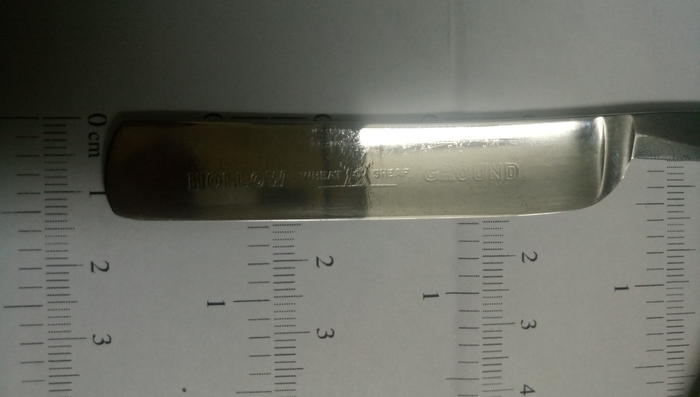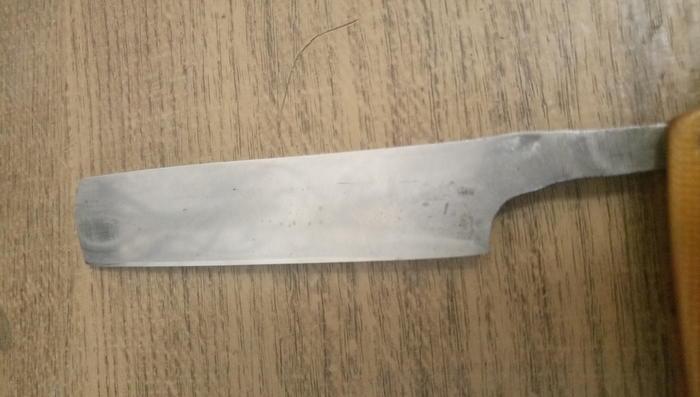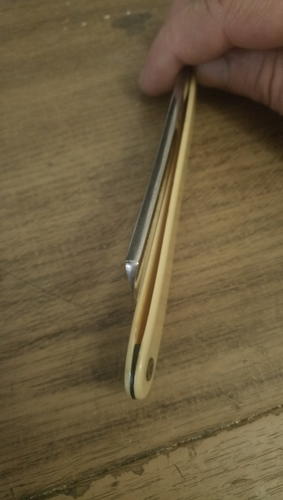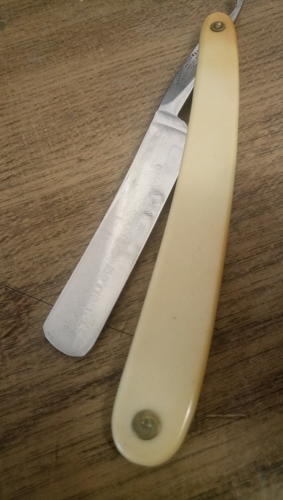Results 1 to 10 of 13
-
10-06-2019, 04:19 PM #1Senior Member

- Join Date
- Feb 2019
- Posts
- 102
Thanked: 7 Wheatley brothers. Little cut throat razor.
Wheatley brothers. Little cut throat razor.
Hello! Tell who that knows about this razor. When did these come out? Why it has such small dimensions (thickness 3.2 mm, width 9+ mm). Also interested in the material scales. In General, I would be grateful for any information.
-
10-06-2019, 04:54 PM #2Senior Member



- Join Date
- Mar 2012
- Location
- Thunder Bay, Ontario, Canada
- Posts
- 17,334
Thanked: 3228
STRAZORS.com - all about classic razors - Wheatley Brothers, Sheffield.
I'd check your width of the blade measurement again. It looks bigger than 9mm in the photo.
https://shavelibrary.com/w/The_strai...ths_and_grinds
BobLast edited by BobH; 10-06-2019 at 04:56 PM.
Life is a terminal illness in the end
-
The Following User Says Thank You to BobH For This Useful Post:
esveka (10-06-2019)
-
10-06-2019, 05:18 PM #3Senior Member

- Join Date
- Feb 2019
- Posts
- 102
Thanked: 7
Oh, I'm sorry. Not 9+, and 14+ mm.
 Corner is obtained ~ 13°. But still it is small
Corner is obtained ~ 13°. But still it is small . Gives a great shave, but a little surprised by the size. I've never seen a razor like that before. I can only assume that it is difficult places on the face. Links these I visited previously, but would still thank you.
. Gives a great shave, but a little surprised by the size. I've never seen a razor like that before. I can only assume that it is difficult places on the face. Links these I visited previously, but would still thank you.
-
10-06-2019, 07:41 PM #4Senior Member



- Join Date
- Mar 2012
- Location
- Thunder Bay, Ontario, Canada
- Posts
- 17,334
Thanked: 3228
No need to be sorry. Looks like you have a roughly 9/16 sized razor which is on the small side for a normal sized razor. There are 3/8 sized razors but I believe they are mainly used for trimming mustaches and beards. Most barbers in the recent past used 5/8 sized razors because that is all they needed to get the job don't and they cost less than the larger sized razors.
I have and use razors in the 4/8, 9/16 and 5/8 range on a regular basis. they do shave well. Size is a personal preference thing.
BobLife is a terminal illness in the end
-
-
10-06-2019, 09:20 PM #5Senior Member




- Join Date
- Dec 2012
- Location
- Egham, a little town just outside London.
- Posts
- 3,857
- Blog Entries
- 2
Thanked: 1083
-
The Following User Says Thank You to markbignosekelly For This Useful Post:
esveka (10-07-2019)
-
10-07-2019, 03:51 AM #6Senior Member

- Join Date
- Feb 2019
- Posts
- 102
Thanked: 7
I have noticed that if a large bristle has grown, it is better to take a wide full or almost wedge from Sheffield: it is easier to cope. But in the problem areas they are not as convenient to shave. But this is a narrow razor copes. Let us assume that you have clarified this question for me. I'm still waiting for answers to other questions: the time of manufacture of the razor (at least before 1900 or after), and the material scales. And one more question: is Wheatley Brothers high, medium or low?
-
10-07-2019, 04:53 AM #7Senior Member



- Join Date
- Mar 2012
- Location
- Thunder Bay, Ontario, Canada
- Posts
- 17,334
Thanked: 3228
A full/true wedge blade is a rare thing as they would be impossible to hone in a normal manner. The closest to a full/true wedge you normally get is a near wedge blade. Yes, a lot of people to find that a large near wedge Sheffield blade seems to plow through whisker more easily for them. I did too at first but now prefer full or extra full hollow blades in the 5/8 to 6/8 range.
As your razor is stamped with Sheffield and not Sheffield England it was most likely made before 1891. IIRC after 1891 country of origin had to be stamped on razors due to an international trade agreement.
I think the scales on your razor have been changed or at least repinned at some point due to flat instead the usual domed washers being used. Hard to say from the photos what the scale material actually is.
I would think Wheatley Brothers made razors were as good as any other razors made in that time period.
BobLife is a terminal illness in the end
-
The Following User Says Thank You to BobH For This Useful Post:
esveka (10-07-2019)
-
10-07-2019, 07:03 AM #8Senior Member

- Join Date
- Feb 2019
- Posts
- 102
Thanked: 7
Thanks, Bob! You gave me a lot of information.
I ask everyone to forgive me for the language. It's machine translation
I was referring, of course, to "near wedge" razors, since I only have one t"rue wedge." I forged it myself and sharpen it with insulation tape glued to the butt.
As for the material of the scales, isn't there an easy way to check: plastic or bone? Me, too, surprised flat pins and broad plate scales, after all they, perhaps, come for blade attack 7/8. But at the same time, these plates are thin and correspond to the thin (3.2 mm) blade of this razor.


In addition, this razor is in very good condition and, apparently, very little used, as well as in the native box. And I had doubts factory pins or handmade. Riveting is not perfect, not very neat. On the other hand, I have a razor with manual, but perfect riveting, which can not be done even with a machine .
.
Last edited by esveka; 10-07-2019 at 07:30 AM.
-
10-07-2019, 11:08 AM #9Senior Member



- Join Date
- Mar 2012
- Location
- Thunder Bay, Ontario, Canada
- Posts
- 17,334
Thanked: 3228
You are welcome. Being a machine translation explains why I am finding it hard to understand but we will get there eventually.
There is the "hot pin" test for ivory. See post #4 in this thread https://sharprazorpalace.com/razors/...ry-scales.html . With bone scales there are all the little cavities where tiny veins run through that collect dirt over time. This makes the surface look kind of speckled with tiny brown spots.
Check with that big auction site on the web to see if they list any Wheatley Brothers razors to see how they are pinned. You will see pretty quickly if yours have factory pinning or not.
BobLife is a terminal illness in the end
-
The Following User Says Thank You to BobH For This Useful Post:
esveka (10-07-2019)
-
10-07-2019, 11:31 AM #10Senior Member

- Join Date
- Feb 2019
- Posts
- 102
Thanked: 7
Despite the fact that google tranlate prevents us, we are moving forward! Bob, I'm surprised I didn't think of that test myself. I was about to pick up the crumbs with the abrasive and try to set it on fire. But I didn't want to Polish the scales afterwards. It turned out to be plastic. Very smelly. I think it's called polystyrene.
Thank you!


 19Likes
19Likes LinkBack URL
LinkBack URL About LinkBacks
About LinkBacks






 Reply With Quote
Reply With Quote
